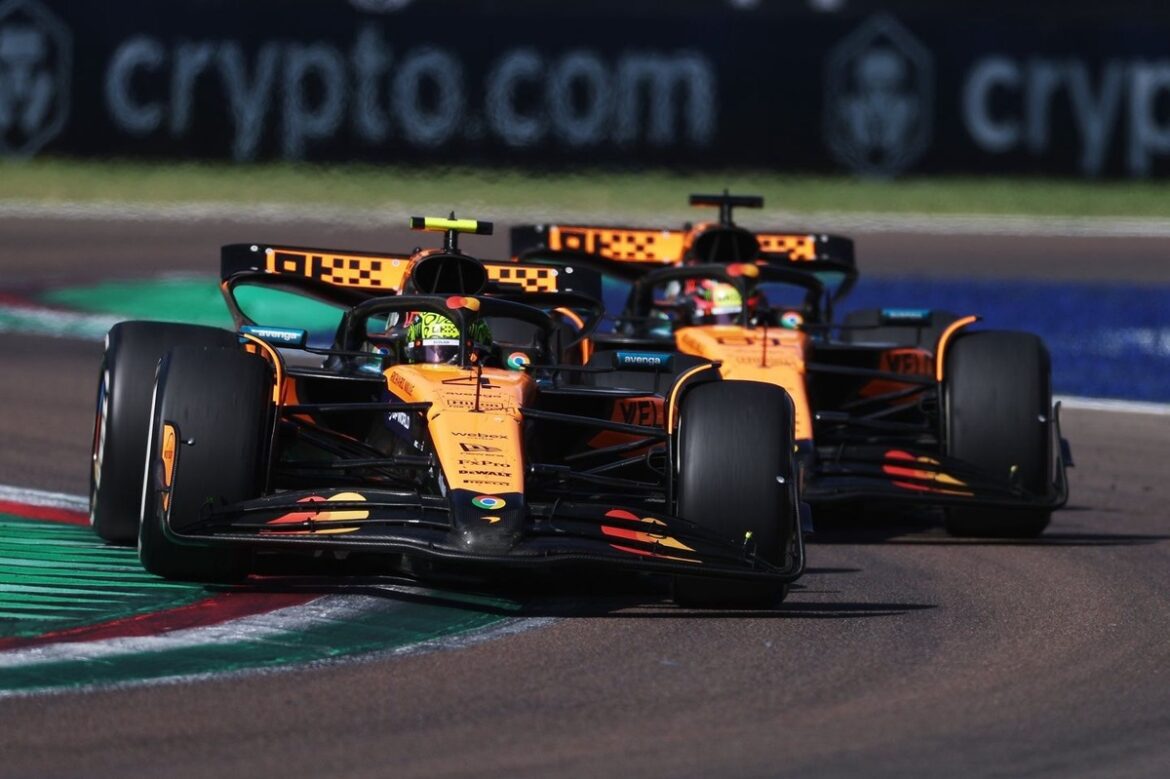McLaren’s Rising Challenge in Formula 1: Insights from the Emilia Romagna Grand Prix
In the dynamic world of Formula 1, the competition is as fierce as ever, with teams constantly jostling for position on the grid. Recently, McLaren has emerged as a significant player in this high-stakes arena, particularly evident during the Emilia Romagna Grand Prix at Imola. The race not only showcased the talents of their drivers, Lando Norris and Oscar Piastri, but also shed light on the complexities of team dynamics in a championship environment.
The Battle for Supremacy at Imola
During the Emilia Romagna Grand Prix, McLaren found themselves in a unique situation with both of their drivers competing for a podium finish. As the race progressed, it became clear that both Norris and Piastri were eager to secure their place in the standings, leading to a thrilling yet precarious scenario. The late-race safety car introduced an additional layer of strategy, which had a significant impact on the outcome.
Norris opted for a pit stop under the safety car, which ultimately positioned him behind his teammate Piastri. This strategic decision was pivotal, as it allowed Norris to challenge Piastri for the second position on the track. The decision not to enforce team orders and let the drivers race against each other was a gamble; it demonstrated McLaren’s commitment to fostering competitive spirit while also raising questions about team cohesion.
The Implications of Driver Rivalry
Christian Horner, the team principal of Red Bull Racing, commented on McLaren’s situation, noting that the presence of two competitive drivers could lead to conflicts of interest. In Horner’s view, when two drivers are vying for the same goal, individual ambitions might overshadow team objectives, potentially undermining overall performance. He remarked, “At some point, self-interest will always outweigh team interest. That’s the conflict.”
This observation resonates deeply in the high-pressure environment of Formula 1, where every second counts, and personal accolades often take precedence over collective success. While allowing Norris and Piastri to race freely was commendable, it also posed the risk of an on-track incident, which could have detrimental effects on the team’s championship standings.
Race Strategy and Tire Management
Horner further elaborated on the race strategies employed by McLaren, particularly noting the challenges they faced with tire management. He highlighted that Piastri had started to experience graining on his front-right tire, which became a pivotal point in the race. Understanding the delicate balance between pace and tire durability is crucial in Formula 1, and McLaren’s decision-making during the race showcased their strategic acumen.
The decision to execute a two-stop strategy instead of a one-stop was a calculated risk. However, the lengthy pit lane at Imola—clocking in at approximately 27 seconds—complicated matters. The pit stop dropped Piastri into a challenging position, thrusting him into traffic while allowing Red Bull’s Max Verstappen to extend his lead. Horner noted, “It put him into a world of pain traffic-wise,” underscoring the complexities of race strategy.
Despite the challenges, both McLaren drivers managed to avoid contact during their battle on the track, demonstrating their skill and discipline. The close encounters at key corners, particularly Tamburello, added drama to the race, highlighting the thin line drivers navigate between aggression and caution.
Red Bull’s Dominance and Strategic Insights
From Red Bull’s perspective, the Emilia Romagna Grand Prix was a demonstration of their superior pace and strategic execution. Horner expressed satisfaction with Verstappen’s performance, emphasizing his ability to manage tire wear effectively while maintaining competitive lap times. This dual capability is essential in securing victories, especially in a race where tire degradation can significantly impact overall performance.
“I think today we had the pace to cover whatever they could throw at us,” Horner stated, reflecting on the team’s strong performance throughout the weekend. The ability to maintain a gap while conserving tires is a hallmark of successful race strategy, and Red Bull’s execution of this was evident during the race.
The Duality of Team Dynamics
The situation at McLaren serves as an interesting case study in the duality of team dynamics within Formula 1. On one hand, allowing drivers to compete freely can foster a healthy competitive environment that pushes them to excel. On the other hand, it introduces the risk of intra-team conflicts that can hinder overall performance and jeopardize championship aspirations.
As McLaren looks to build on their recent successes, striking the right balance between individual ambition and team cohesion will be crucial. The challenge lies in ensuring that both drivers feel empowered to compete while also recognizing the importance of collaboration in achieving collective goals.
Looking Ahead: McLaren’s Future in Formula 1
As the Formula 1 season unfolds, McLaren’s trajectory will be closely watched by fans and analysts alike. The emergence of both Norris and Piastri as formidable contenders adds an exciting layer to the championship narrative. However, the team must navigate the intricacies of driver relationships and strategic decision-making to maximize their potential.
With the right approach, McLaren can harness the competitive spirit of their drivers while ensuring that their focus remains on securing valuable points in the championship standings. The lessons learned from the Emilia Romagna Grand Prix will undoubtedly inform their strategies in upcoming races as they seek to solidify their position as a leading team in Formula 1.
Conclusion
The Emilia Romagna Grand Prix showcased not only the talents of McLaren’s drivers but also the complexities of team dynamics in Formula 1. As competition intensifies, the interplay between individual aspirations and team objectives will continue to shape the narrative of the season. McLaren’s ability to adapt and evolve in response to these challenges will be key to their success in the world of Formula 1 racing.
